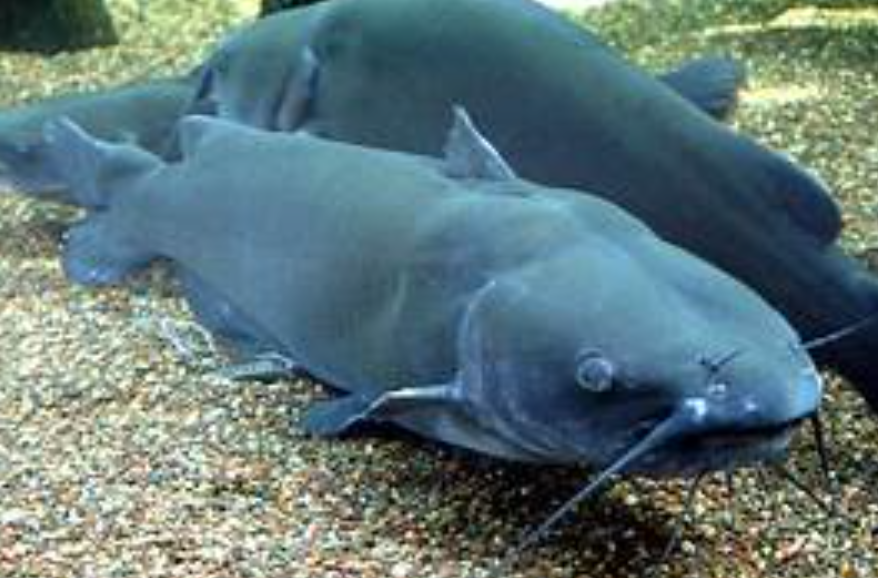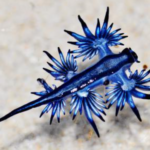Quick Top 10 Facts about Blue Catfish
| SCIENTIFIC NAME | Ictalurus furcatus |
| CLASSIFICATION |
KINGDOM: Animalia PHYLUM: Chordata CLASS: Actinopterygii ORDER: Siluriformes FAMILY: Ictaluridae GENUS: Ictalurus SPECIES: Ictalurus furcatus |
| SIZE | Can grow up to 5 feet in length and weigh over 100 lbs |
| HABITAT | Freshwater rivers and lakes, typically found in slow-moving or deep water |
| DIET | Carnivorous; feeds on smaller fish, crayfish, and other aquatic invertebrates |
| SPECIES | Blue Catfish is the largest species of catfish in North America |
| COUNTRY | Native to the rivers of North America, particularly the Mississippi River basin |
| GESTATION PERIOD | Blue Catfish are egg-layers; the eggs hatch in about 4-10 days, depending on the water temperature |
| LIFE SPAN | Can live up to 20 years or more in the wild |
| CONSERVATION STATUS | Not currently endangered, but overfishing and habitat disruption can impact their populations |
Amazing Facts About Blue Catfish
1. Known for their size
Blue Catfish are the largest species of catfish in North America, with some individuals reaching over 5 feet in length and weighing more than 100 lbs.
2. Excellent predators
These catfish are skilled hunters, using their strong sense of smell and whiskers to detect prey in the dark, murky waters.
3. Deep-water dwellers
Blue Catfish prefer deep, slow-moving water and can be found in the Mississippi River basin and other large freshwater systems.
4. Long lifespan
Blue Catfish can live for over 20 years, making them one of the longest-living species of freshwater fish.
5. Unique blue-gray color
Their bluish-gray coloration helps them blend into the waters of the rivers and lakes where they reside.
6. Strong swimmers
These catfish are powerful swimmers, capable of navigating swift currents in search of food.
7. They can grow rapidly
Blue Catfish are known to grow quickly in the right environment, reaching sizes of 40-50 pounds in just a few years.
8. Important for the ecosystem
As apex predators, Blue Catfish play an essential role in maintaining the balance of the freshwater ecosystem by controlling populations of smaller fish and invertebrates.
9. They are bottom-feeders
Blue Catfish are often found feeding on the bottom of rivers and lakes, scavenging for food in the silt and mud.
10. Popular for fishing
Due to their size and strength, Blue Catfish are a popular target for anglers who enjoy big-game fishing.
Origin of blue catfish, including their size and habitat
The blue catfish, scientifically known as Ictalurus furcatus, is a species of freshwater fish native to the Mississippi River basin. Their peculiar blue-grey coloration is the reason they earned their nickname. It has been said that some of these fish may grow to be over five feet long and weigh more than 100 pounds. They may become really big eventually.
Feeding habits of blue catfish, emphasising their opportunistic and carnivorous nature
Blue catfish are opportunistic predators with a varied diet. Although they have been seen to consume insects, crabs, and even small mammals, their primary diet consists of other fish, including sunfish and shad. Their sharp, barbed pectoral spines and strong jaws make them excellent predators that can swiftly capture and consume their prey.
Blue catfish and its significance in the aquatic world
Fishermen like blue catfish for their power and size, making them intriguing fish. They are an intriguing species to study because of their enormous size, distinctive look, and varied nutrition. We can preserve the long-term survival of blue catfish while continuing to enjoy the excitement of capturing them by adhering to the correct fishing methods.
natural habitat of blue catfish, including the types of water bodies they inhabit
One interesting characteristic of blue catfish is their ability to live in a range of environmental conditions. Given that they can survive in both warm and cold seas and that they can adapt to different salinity levels, they are very versatile. Because of their adaptability, they have become successful invasive species in areas where native fish populations have been driven out. In addition, blue catfish are known for having long lives; some have been known to reach 20 years of age.

Fascinating facts about Blue catfish
Ictalurus furcatus, the scientific name for the blue catfish, is a type of freshwater fish that is indigenous to North America. It is well-known for its size and power and is a favourite game fish. We’ll look at some fascinating information about blue catfish below.
Size and Weight of Blue Catfish
One of the biggest species of catfish in North America is the blue catfish. The typical adult may reach astonishing lengths of 20 to 40 inches and weigh between 20 and 40 pounds. But they can grow up to five feet long and weigh more than a hundred pounds.
Distinguishing features such as their deeply forked tail and prominent barbels
The bluish-grey coloration on the body of the blue catfish gives it its name. Its tail is deeply divided, and its body is long and lean. Its big mouth is filled with sharp teeth, and its skull is wide and flat. They are distinct from other catfish species due to their smooth, scale-free skin.
Habitat and Distribution: natural habitat of blue catfish
The Mississippi River watershed and its tributaries are home to native blue catfish. Lakes, reservoirs, and large rivers with deep pools and leisurely currents are home to them. They choose places that are covered, including fallen trees, boulders, and underwater plants.
Nutrition and Diet: Feeding Behaviour
Blue catfish have a varied diet and are opportunistic eaters. They mostly eat other fish, including smaller catfish, sunfish, and shad. Additionally, they have been seen to consume insects, crabs, and even small animals or birds that fall into the water.
Reproductive behaviour of blue catfish, including their spawning habits
Blue catfish mature sexually between the ages of two and four. Summertime brings them out to spawn since the water is warmer. The male vigilantly guards the nest, where the female deposits her eggs. The male guards the fry until they can swim and take care of themselves when they hatch.
increasing popularity of blue catfish as a sport fish
Because of their size and fighting prowess, fishermen greatly prize blue catfish. The following advice will increase your likelihood of getting a blue catfish.
Make use of robust fishing gear since blue catfish may be fierce opponents. Use cut bait, such as prawns or chicken liver, or live bait, such as shad or sunfish. Aim for locations with deep water and concealment, including drop-offs or submerged buildings. When blue catfish are more active, try fishing in the early morning or late evening.

Conservation efforts and management strategies
The populations of blue catfish are usually steady and not in danger. But habitat degradation and overfishing may be a danger to their population. For blue catfish populations to be sustainable, fishermen must engage in ethical fishing practices and follow local laws.
FAQ (Frequently Asked Questions) about Blue Catfish
Q: What is a Blue Catfish?
Ans: The Blue Catfish (Ictalurus furcatus) is a large species of freshwater fish native to North America. Known for its bluish-gray coloration and large size, the Blue Catfish is a popular game fish, primarily found in rivers and lakes. It is known for its strength and is often sought after by anglers for sport fishing.
Q: How big does a Blue Catfish get?
Ans: Blue Catfish can grow to be quite large, with individuals reaching lengths of up to 5 feet (1.5 meters) and weighing over 100 pounds (45 kg). While most blue catfish caught in the wild are smaller, the largest individuals can grow to be quite impressive, making them a sought-after prize for fishermen.
Q: Where are Blue Catfish found?
Ans: Blue Catfish are primarily found in the central and eastern United States, especially in the Mississippi River and its tributaries. They have also been introduced to other areas across the U.S., including the Chesapeake Bay region. These fish prefer large, slow-moving rivers and reservoirs.
Q: What do Blue Catfish eat?
Ans: Blue Catfish are opportunistic feeders and primarily eat fish, but they will also consume smaller aquatic animals like insects, crustaceans, and even plant material. They are known to be scavengers and will eat almost anything they can find, including dead fish. In the wild, they are often found in deeper waters where they hunt for prey.
Q: Are Blue Catfish dangerous?
Ans: While Blue Catfish are not inherently dangerous to humans, their size and power can make them challenging to handle, especially when caught. They have sharp spines on their dorsal and pectoral fins, which can cause injury if not handled carefully. Additionally, due to their large size, they can put up a strong fight when caught by fishermen.
Q: How long do Blue Catfish live?
Ans: Blue Catfish have relatively long lifespans compared to many other fish species. In the wild, they can live for up to 20 years or more, although most individuals caught by anglers are much younger, often around 5 to 10 years of age. Their growth rate is dependent on factors such as habitat and food availability.
Q: Are Blue Catfish good to eat?
Ans: Yes, Blue Catfish are considered to be good eating. They have firm, mild-flavored white meat, making them popular in many recipes. However, larger Blue Catfish may have a stronger, more “fishy” taste due to their size and diet, and smaller fish are often preferred for eating. Blue Catfish is commonly fried, grilled, or smoked.
Q: How do Blue Catfish reproduce?
Ans: Blue Catfish spawn in the spring when water temperatures reach about 75°F (24°C). They prefer to spawn in shallow areas of rivers with rocky or gravelly bottoms. During spawning, males build nests and attract females. After mating, the female lays her eggs, and the male guards the nest until the eggs hatch. The young catfish are left to fend for themselves once they are born.
Q: What is the habitat of a Blue Catfish?
Ans: Blue Catfish are typically found in deep, slow-moving waters of large rivers and reservoirs. They prefer areas with plenty of structure, such as submerged logs, rocks, and drop-offs. During the warmer months, they are often found in deeper waters, while they may move to shallower areas during cooler months or for spawning.
Q: Can Blue Catfish be kept in an aquarium?
Ans: While it is possible to keep a Blue Catfish in an aquarium, it is generally not recommended for most hobbyists due to their large size. As they grow, they require a very large tank with plenty of space to swim. Additionally, their size and feeding habits make them more suitable for outdoor ponds or large, open-water environments.
#BlueCatfish, #FreshwaterFishing, #Catfish, #GameFish, #SportFishing, #AquaticLife, #Fishing, #RiverFish, #Wildlife, #Anglers, #FishingLovers, #MississippiRiver, #OutdoorAdventure, #FishSpecies
Our sources and references about Blue Catfish
1: Wikipedia – Blue Catfish
2: FishWatch – Blue Catfish
3: Missouri Fishing Regulations – Blue Catfish
4: Outdoor Life – Blue Catfish Fishing


